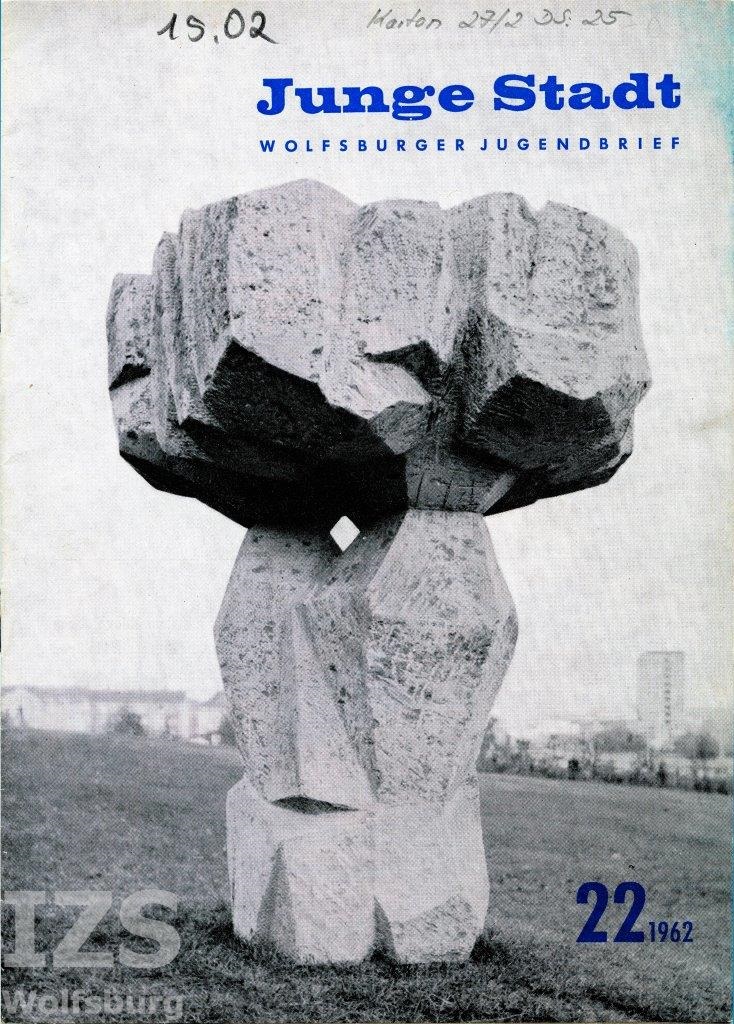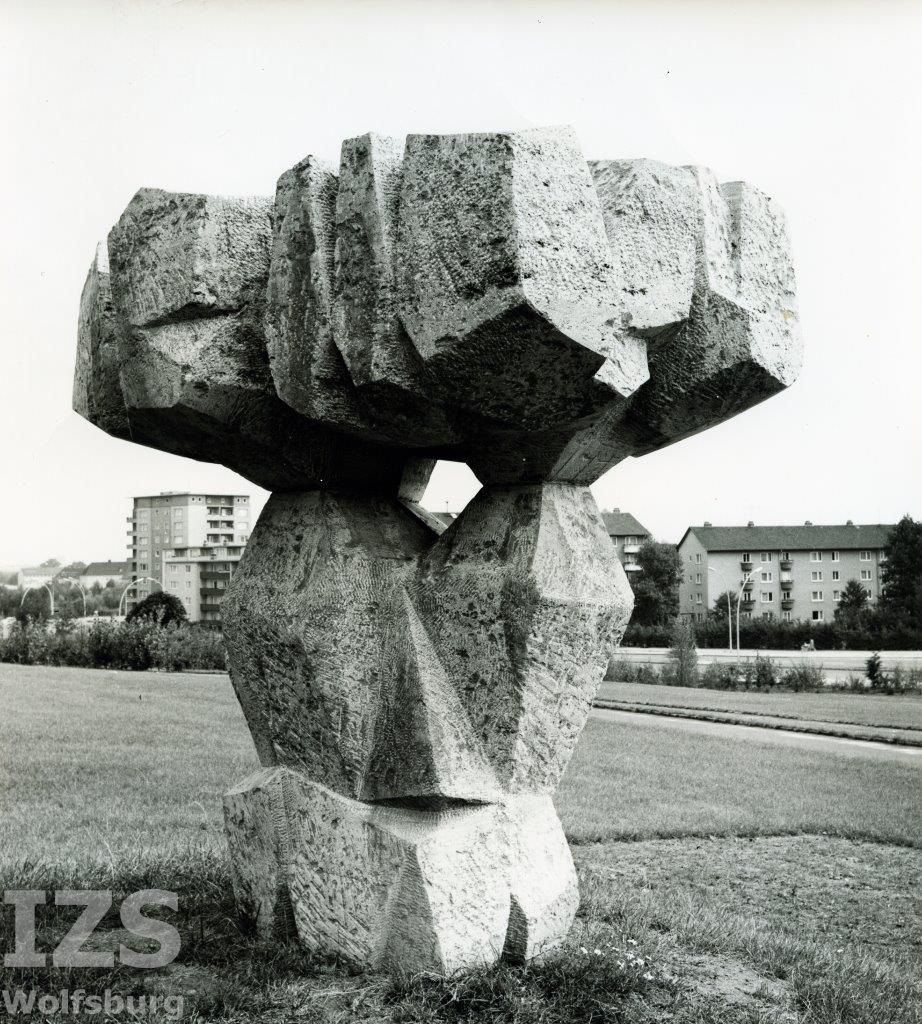Loads and Carrying, Joseph Henry Lonas (1961)
From Maik Ullmann
If a commentary in the Wolfsburger Nachrichten is to be believed, the sculpture Lasten und Tragen by the American artist Joseph Henry Lonas established itself in the collective memory of Wolfsburg's urban society in the 1960s as a "molar" (Fig. 1).-__-0000-__- Erected on the eastern slope of the Klieversberg in the fall of 1962, the stone sculpture is one of the oldest sculptures placed in public spaces by the municipality. Due to its mushroom-like shape and height of three meters, the twelve-ton outdoor sculpture caused quite a stir at the time. In 1962, for example, it adorned the cover of the twenty-second issue of the Wolfsburg Youth Newsletter (Fig. 2).


The local population imaginatively came up with numerous interpretations for Lonas' sculpture: five years after it was erected, one citizen wrote a letter to the editor asking how the modern art on the Klieversberg was to be understood at all. After reading William Shakespeare's tragedy Macbeth from the furrows and corners of the stone himself, a hiker apparently pointed out to him that the Lonas sculpture was not art at all: '"We builders like to pile up leftover chunks of stone out of convenience and then have fun when harmless minds think it's art."'-__-0000-__- The citizen in question had also asked "the youth" about loads and loads. The Liverpool rock band The Beatles, who were at the height of their career in 1967 after the release of their album Sgt. Pepper's Lonely Hearts Club Band and were idolized in many places, were seen as a pop cultural inspiration.
The citizen constantly asked around among the population. He also came across the legend that the shell limestone sculpture was an advertisement for a dentist, which he considered to be the most plausible explanation. Although he was merely making use of urban gossip, which he embellished in literary form for his letter to the editor, he also used it as an example to illustrate the extent to which art in the cityscape can awaken the imagination of citizens and how they can relate to an object.
Although the sculpture was initially installed on loan near the Scharoun Theater in 1962, it was not officially purchased by the city of Wolfsburg for DM 19,000 until the winter of 1963. "The stone is rolling", -__-0001-__- exulted Dr. Peter Lufft, then head of cultural affairs, in a letter to the artist. Formed from two monoliths, "the stone compels us to succinct forms and to a constant confrontation with its essence", -__-0002-__- recognized the Deutsche Zeitung in September 1961. On viewing a photograph of the sculpture presented by the head of the city council, Dr. Wolfgang Hesse, the members of the city's art purchasing committee quickly agreed that they could see something special in it. The city council also recognized an educational aspect that the installation would promote. It would be a good opportunity to bring the people of Wolfsburg into contact with modern art. -__-0003-__-
City planning officer Rüdiger Recknagel had previously personally inspected the sculpture at a sculptors' symposium in the Lower Franconian district of Würzburg. "-__-0004-__-strongly impressed" by its appearance,-__-0005-__- he strongly recommended the purchase of the stone sculpture to the culture committee. Even if the works of the sculptors Herbert Baumann and Erich Reischke, for example, were just as interesting, Lonas' Lasten und Tragen stood out (Fig. 3). -__-0006-__- During an inspection of the sculpture by a delegation from the cultural committee, the last remaining doubts were dispelled: "The visit to the quarry near Würzburg also took place in pouring rain. We can now remove the work of the Berlin-American without any reservations. It is without doubt the best work of the symposium." -__-0007-__-

While the city and artist had initially agreed to place the sculpture in Wolfsburg on loan,-__-0000-__- this agreement was to be steered in a different direction by the municipality only a short time later. In the meantime, the Berlin Senate also expressed its interest in the sculpture made of shell limestone. The sculpture was also reported on nationally, for example in the Deutsche Zeitung and the Wirtschaftszeitung. Photographer Heinrich Heidersberger, who had only moved to Wolfsburg at the beginning of the decade and was a member of the Schloßstraße 8 artists' group there, provided the appropriate photography. The artist Olga Szaif-Pawlowa, also a member of the artists' group, also pointed out to the city's press office that the Lonas sculpture was also featured in the TV magazine HörZu. "The magazine is known to be the most widely distributed radio and television program magazine with a circulation of millions",-__-0001-__- the press office then informed Chief City Director Hesse. Peter Szaif, founding member of the Schloßstraße 8 collective, apparently acted as mediator between the city administration and Lonas in the negotiations:
"Mr. Szaif expressly advised Mr. Lonas to set the price as lowas possible.Of the 19,000 DM, Mr. Lonas must give the quarry company 8,000 DM as the pure cost of the material. All artists at the Symposium have made this commitment in the event that their works are sold.Mr. Lonas has an obligation to the management of the Symposium to pay 25% = DM 4,750 of the purchase price."-__-0002-__-
Lonas apparently agreed to the sale under the negotiated conditions; the purchase took place in January 1963. -__-0003-__- Chief Town Clerk Hesse expressed his personal thanks to the artist: "The town of Wolfsburg has thus gained a work of art as an outdoor sculpture, which the population - as I have already been informed by various parties - has grown fond of in the short time it has been on display."-__-0004-__- (Fig. 4)

Lasten und Tragen was created in the context of the aforementioned symposium of European sculptors in mid-1961. From June to September, a group of sculptors from different countries worked on sculptures made from shell limestone blocks in a quarry in Kirchheim, Gaubüttelbrunn. -__-0000-__- The idea of a workshop community consisting of international artists was an initiative of the Austrian artist Karl Prantl, who had already held similar sculptors' symposia in St. Margarethen in the Austrian Burgenland in 1959 and 1960 and now exported this idea to the Federal Republic of Germany. In addition to Prantl, nine other artists were involved in the project at the time, including Yasuo Mizui, who is no stranger to Wolfsburg today, having created a limestone fountain for the city. Lonas, a Berliner by choice, was also one of the artists. Initially the focus was solely on art, but during the symposium the group of sculptors also reacted politically to the building of the Berlin Wall. Over the next two years, they held further symposia in the now divided Berlin and donated stone memorials against war and violence in Berlin's Tiergarten. The Lonas sculpture on the Klieversberg was born out of an idea that called for democracy and an international community. Erected in Wolfsburg, in what was then the "border zone", the figure is therefore neither a pop culture monument nor a homage to William Shakespeare, but should be interpreted as an urban commitment to peaceful coexistence.
Sources
-__-0000-__- Commentary, in: Wolfsburger Nachrichten of February 12, 1969.
-__-0001-__- P.L., "Wouldn't you like an explanatory word z...", in: Wolfsburger Nachrichten of November 5, 1967.
-__-0002-__- IZS Wolfsburg, Az. 41 51 10-L1, Kunst im Stadtbild, Kulturreferent Lufft to Lonas, October 12, 1962.
-__-0003-__- "Zwiesprache mit dem Stein", in: Deutsche Zeitung of September 26, 1961.
-__-0004-__- IZS Wolfsburg, Az. 41 51 10-L1, Kunst im Stadtbild, excerpt from the minutes of the 58th meeting of the administrative committee on August 28, 1962.
-__-0005-__- IZS Wolfsburg, ref. 41 51 10-L1, Art in the cityscape, excerpt from the minutes of the 12th meeting of the Culture Committee on June 19, 1962.
-__-0006-__- IZS Wolfsburg, ref. 41 51 10-L1, Kunst im Stadtbild, excerpt from the minutes of the 4th meeting of the Art Acquisition Advisory Board on June 26, 1962.
-__-0007-__- IZS Wolfsburg, Ref. 41 51 10-L1, Art in the Cityscape, Subject: Installation of a sculpture by the sculptor Lonas dated September 11, 1962.
-__-0008-__- IZS Wolfsburg, ref. 41 51 10-L1, Art in the cityscape, Lonas to Lufft dated March 25, 1962.
-__-0009-__- IZS Wolfsburg, ref. 41 51 10-L1, Kunst im Stadtbild, press office to Oberstadtdirektor Hesse of December 14, 1962.
-__-0010-__- Ibid.
-__-0011-__- IZS Wolfsburg, ref. 41 51 10-L1, Kunst im Stadtbild, excerpt from the minutes of the Finance Committee of January 14, 1963.
-__-0012-__- IZS Wolfsburg, ref. 41 51 10-L1, Art in the cityscape, Hesse to Lonas dated December 19, 1962.
-__-0013-__- "Bildhauer geben steinerne Visitenkarte ab", in: Fränkisches Volksblatt of June 8, 1961; "Consul Hellmut Metzing, then owner of Natursteinwerke Zeidler & Wimmel, provided the sculptors with the stone blocks free of charge, which enabled the young artists to work not only in small formats, but in large dimensions, not only in the studio, but in the open air." "Such a beautiful thing. Listed collection of monumental sculptures in the Kaiserstein quarry in Gaubüttelbrunn for 50 years", in: Mainpost of September 6, 2011, available online at https://www.mainpost.de/regional/wuerzburg/so-etwas-schoenes-art-6315599 -__-0014-__-.
